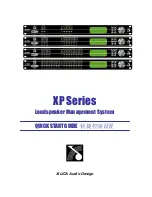
46
ARK series
EN
IT
rimanenti due terminali rimasti scollegati. I loro
valori si sommano: per esempio, due altoparlan-
ti da 8 Ohm in serie danno 16 Ohm.
Quando gli altoparlanti sono collegati in paral-
lelo, i terminali dello stesso segno sono uniti tra
loro. Per ottenere il valore totale bisogna utilizza-
re una formula, indicando con R1 ed R2 i valori
di due altoparlanti, ed eseguire: (R1xR2)/(R1+R2).
Con due altoparlanti da 8 Ohm, per esempio,
avremo: (8x8)/(8+8)= 64/16= 4 Ohm. In pratica
collegando due altoparlanti uguali in parallelo il
valore si dimezza. La lunghezza dei cavi di colle-
gamento deve essere ridotta al minimo neces-
sario.
Come scegliere l’amplificatore
La potenza di lungo termine AES, rappresenta la
potenza termica dissipabile dal diffusore o dai
singoli altoparlanti, viene misurata secondo lo
standard AES, che prevede un test di 2 ore con
segnale pink noise, fattore di cresta 2; la potenza
viene determinata dalla tensione RMS al quadra-
to divisa per l’impedenza minima del diffusore o
del singolo altoparlante. La potenza dell’amplifi-
catore consigliato non viene misurata, ma è pari
al doppio della potenza AES e tiene conto delle
capacità dinamiche degli altoparlanti di soppor-
tare picchi di potenza per brevi istanti di tempo.
Il valore fornito corrisponde alla potenza RMS che
l’amplificatore deve avere per fornire il segnale di
test (pink noise con fattore di cresta 2) usato per
misurare la potenza AES. Un amplificatore con
tale potenza, se usato con segnali musicali con
fattore di cresta maggiore o uguale a 6dB, per-
mette di ottenere il massimo delle prestazioni del
diffusore, erogando una potenza di lungo perio-
do non superiore a quella AES del diffusore.
Se, viceversa, si usano segnali musicali molto
compressi o il volume viene alzato fino al punto
da spingere fortemente in clipping l’amplifica-
tore, allora, la potenza effettiva di lungo perio-
do erogata, tende a raggiungere o addirittura
superare quella RMS dell’amplificatore, danneg-
giando in modo irreparabile gli altoparlanti. Con
questo tipo di segnale è consigliabile usare un
amplificatore con potenza RMS pari alla potenza
AES del diffusore, facendo comunque attenzio-
ne a non fornire un segnale di ampiezza tale da
portare troppo spesso in clipping l’amplifica-
ance value corresponds to the amplifier output
impedance.
There are 2 possible connection systems: serial
or parallel mode.
Connecting two speakers in series means to
connect the positive pole of the first speaker to
the negative pole of the second one and then
to connect the two free poles to the amplifier.
In this case the impedance values are summed
up: e.g. Two 8 Ohm speakers connected in paral-
lel give a 16 Ohm load. To connect two speakers
in parallel mode, simply interconnect the two
speakers terminals of the same sign. To obtain
the total value, in this case a calculation is re-
quired. Indicating R1 and R2 as the two loud-
speaker values, the following formula has to be
used: (R1xR2)/(R1+R2).
E.g.: with two 8 Ohm speakers, we have that:
(8x8)/(8+8)= 64/16= 4 Ohm, that is to say that
when identical speakers are connected in paral-
lel, the impedance value is halved.
Choosing the right amplifier
According to the AES standard, tests run on the
components require a two-hour stressing of a
filtered pink noise signal with a pass band of a
decade and with a crest factor (average value
and peak value ratio) of 6 dB.
For common applications which require both a
high power and a high reliability level, it is ad-
visable to use power amplifiers with an output
rating equivalent to the AES power rating of the
enclosures. This ensures that the enclosures will
operate within their thermal limit specification.
For applications where the user desires to take
advantage of the full applicable power of the
enclosures, it is possible to use amplification
with output power ratings equal to the program
output rating of the enclosures.
In this configuration, the full capacity of the sys-
tem to handle transient power is utilised, how-
ever it will be necessary to constantly monitor
and regulate the system very carefully in order
to avoid overloading the speakers. It is also nec-
essary to avoid that loudspeakers are subject to
signals which could cause them to exceed their
mechanical limits or their applicable frequency
limits.
In practice, it is possible to damage a loud-







































